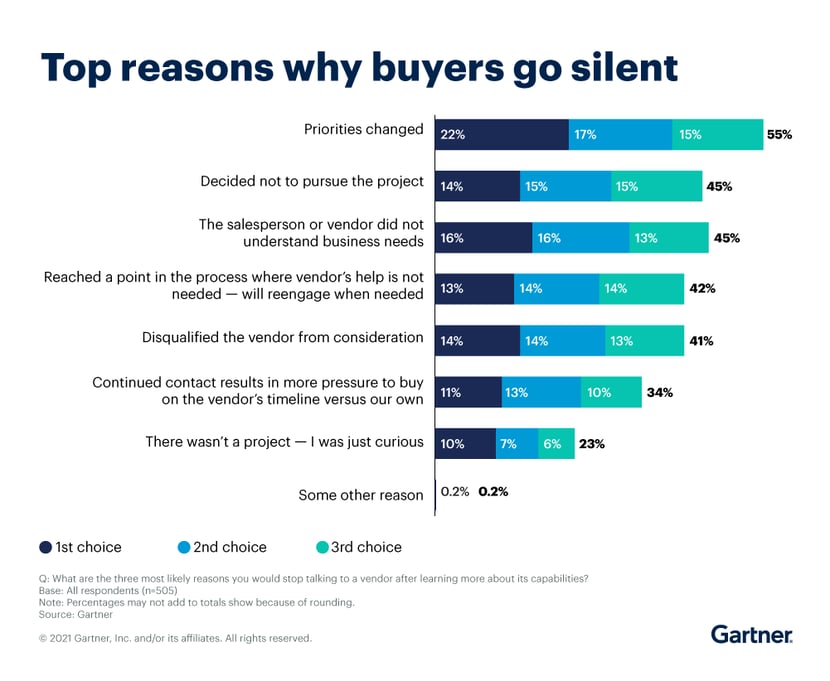- Solutions
-
Products
-
Resources
Sales Automation: What It Is, How It Works, and What to Automate First by Kristi Campbell View all Blog Posts >Get the App, Get the Sidebar, & Get Your Trial Going HereUnleash limitless growth opportunities by partnering with Cirrus Insight.
- Pricing
Filter By:
- All topics
- Sales Intelligence
- Salesforce
- Sales Productivity
- Sales Strategy
- Sales Prospecting
- Book More Meetings
- Sales Activity Data
- Company News
- Sales Leadership
- Sales Metrics
- Team Scheduling
- Prospect Smarter
- AI
- Serious Insights
- Comparison
- Conversation Intelligence
- Sync To Your CRM
- Email Blast
- Email Campaigns
Re-Engage Cold Leads With Proven Email Tactics
Is your sales team making the most of their leads? It’s easy to let leads go cold when they aren’t ready to convert right away, without ever following up again. Don’t let your sales reps throw away these qualified leads—teach them to re-engage and make a meal out of them.
Table of Contents
- Why do leads turn cold?
- Re-engage cold leads with nurturing strategies
- Cold leads email templates that work
- Automate and track cold leads outreach at scale
Why Do Leads Turn Cold?
Even the most promising leads can suddenly go silent. But before you give up on them, it's important to understand why they’ve gone cold in the first place. Pinpointing the cause can help you tailor your re-engagement strategy and boost your chances of reigniting the conversation.
Poor Timing
Timing is everything in sales. A lead might have shown interest during a busy quarter or while navigating internal changes. In fact, studies show that only 25% of new leads are sales-ready right away, according to Gleanster Research. The rest? They're not saying “no”—they're saying “not yet.”
Lack of Follow-Up
Leads go cold when they’re left in the dark. Failing to stay top-of-mind is one of the fastest ways to lose momentum.
Shifting Priorities
Businesses evolve. A solution that was top priority a month ago might no longer be relevant today. Budget changes, leadership shifts, or strategic pivots can all push your offering to the back burner. What’s critical is understanding those shifts so your outreach reflects the lead’s current reality.
Lack of Personalization
Inboxes are flooded. If your emails feel generic or irrelevant, they’re likely to be ignored. When outreach feels like a broadcast instead of a conversation, it’s easy for leads to tune out.

Re-Engage Cold Leads With Nurturing Strategies
Just because a lead has gone cold doesn’t mean they’re lost forever. With the right nurturing strategies, you can reignite interest, rebuild rapport, and guide them back into your sales funnel. The key? Be relevant, be consistent, and be valuable.
Send a Hyper-Personalized Check-In Email
Generic follow-ups fall flat. Instead, reference specific details from your previous interactions—like a pain point they mentioned or a product they were considering. Use their name, company info, and relevant industry context to demonstrate you’ve done your homework.
Example:
“Hi Jamie, I saw that your team at Acme Inc. just launched a new product line—congrats! When we last connected, you mentioned needing a better way to manage customer onboarding. Still looking for a solution?”
Pro tip: Tools like Cirrus Insight and Salesloft allow you to automate personalization at scale without sacrificing quality.
Provide Value With Educational Content
Instead of going straight for the pitch, share helpful, relevant content based on their interests or pain points. This positions your brand as a helpful resource rather than a pushy salesperson.
Try sending:
-
A case study showing how a similar company solved the same challenge
-
A short video demo tailored to their use case
-
A blog post (like this one!) that provides insight into a current industry trend
Competitor Insight:
Companies like Gong and Outreach.io frequently use intent-driven content in their email cadences to rewarm cold leads. They focus on delivering insights, not selling upfront.

Leverage Multiple Channels Strategically
If email alone isn’t working, mix in other touchpoints like LinkedIn messages, direct mail, or even a quick voicemail. A well-timed social interaction can rekindle interest more naturally.
Example Multichannel Approach:
-
Day 1 – Personalized email with value-add content
-
Day 3 – LinkedIn connect request + comment on a relevant post
-
Day 6 – Follow-up email with a new insight or offer
-
Day 9 – Short voicemail: “Just wanted to see if this is still on your radar…”
Consistency across channels reinforces your message and increases the chance of engagement.
Create Time-Sensitive Offers to Spark Action
A little urgency can go a long way. Whether it’s a limited-time discount, early access to a feature, or a spot in an exclusive webinar, giving cold leads a reason to act now can nudge them out of limbo.
Example Subject Line:
“Still interested? Your exclusive access expires Friday ⏳”
Just make sure your offer aligns with their previous interest—this isn’t about pressure, it’s about relevance.
Cold Leads Email Templates That Work
Need inspiration to warm up a quiet inbox? Use these proven, real-world email templates designed to reconnect with leads in a natural and engaging way. Whether you're sparking curiosity, offering value, or asking for direction, these templates make it easy to start the conversation again.
1. The Genuine “Still Interested?” Check-In
Subject: Still on your radar?
Body:
Hi [First Name],
We chatted a while back about [pain point or topic discussed]—and I just wanted to check in to see if it’s still a priority for you or if things have shifted.
No pressure either way. Just happy to reconnect if the timing makes sense.
CTA: Let me know if it’s worth revisiting or if I should circle back later in the year.
2. The Curiosity-Driven Hook
Subject: Quick idea for [Their Company]
Body:
Hey [First Name],
I’ve been thinking about how [Their Company] handles [specific challenge], and a few new ideas came to mind that might be worth sharing—especially after seeing [relevant news or trigger event].
Would love to get your take on it if you're open to a quick chat.
CTA: Want me to send over a few ideas for you to review?
3. The Consultative Value Drop
Subject: Thought this might be useful
Body:
Hi [First Name],
I just came across a case study about how a similar team solved [shared challenge]—and immediately thought of you. It’s a quick read and could help with [relevant goal or outcome].
No strings attached—just passing along something valuable.
CTA: Want me to send it over?
4. The Referral Ask
Subject: Not the right fit—or know who might be?
Body:
Hey [First Name],
Totally understand if this isn’t a fit right now. But I figured I’d check—do you know someone else on your team or in your network who might benefit from [brief description of your solution]?
Happy to be a resource where I can.
CTA: If someone comes to mind, feel free to introduce us—or just point me in the right direction.
5. The “Let’s Reboot” Touchpoint
Subject: Reconnecting—worth another look?
Body:
Hi [First Name],
When we last spoke, it sounded like [brief summary of previous interest or challenge] was a top priority. If that’s still the case, I’d love to share some of the updates we’ve rolled out since then—might be worth revisiting.
Either way, always happy to reconnect and hear how things are going on your end.
CTA: Open to a quick 15-minute call next week?
6. The Soft Re-Engagement with No Ask
Subject: Hope you’re doing well
Body:
Hi [First Name],
Just wanted to drop a quick note to say I appreciated our last conversation. Hope things are going great at [Their Company].
No pitch here—just wanted to stay in touch in case there’s anything I can help with down the road.
CTA: Feel free to reach out anytime. I’m always around if you need anything.
Automate and Track Cold Leads Outreach at Scale
Reaching out to cold leads manually is time-consuming—and without visibility into engagement, it’s easy to lose track of what’s working. That’s where Cirrus Insight comes in.
Our platform helps you streamline your re-engagement strategy with powerful tools designed to scale personalized outreach and track performance every step of the way.
Automate Cold Email Campaigns Without Losing the Personal Touch
Cirrus Insight lets you build automated, yet highly personalized email cadences tailored to each lead’s activity, interests, or past interactions. Use dynamic fields and behavior-based triggers to send the right message at the right time—no spreadsheets or guesswork required.
Track Opens, Clicks, and Replies in Real Time
Want to know who’s actually reading your follow-ups? With Cirrus Insight, you can see exactly when a lead opens your email, clicks a link, or replies—so you can prioritize warm responses and adjust your outreach based on what’s working.
Scale Outreach Without Sacrificing Quality
Manage your entire re-engagement process—across hundreds or thousands of leads—right from your inbox. Set follow-up reminders, build automated sequences, and keep your CRM up to date automatically.
Bonus: Built-In Scheduling and AI-Powered Prep
Book meetings faster with Smart Scheduler and prepare like a pro with Meeting AI, which pulls relevant research on each contact before your call—so every touchpoint feels meaningful, not generic..png?width=650&height=510&name=meetingai%20-%20view%20(1).png)
Conclusion
Cold leads aren’t exactly cold—you have at least a sliver of a relationship with them, so you can’t brush them off or just send a quick email. You can’t be impersonal, either, because you already talked to them. You need to reach out succinctly, yet personally, with information of some value, in order to ignite a potential “aha” moment and remind that person why they were considering working with you in the first place.
Frequently Asked Questions (FAQs)
How to reheat cold leads?
Start by reconnecting with empathy and context. Reference previous conversations or shared interests, and offer value—like a relevant case study, resource, or industry insight. Use a mix of channels (email, LinkedIn, voicemail) and personalize each touchpoint to show you’re not just blasting out mass emails.
Who are cold leads?
Cold leads are prospects who previously showed interest but have since stopped engaging. They may have gone dark due to timing, shifting priorities, budget constraints, or lack of follow-up.
How to follow up cold leads?
Reach out with a concise, thoughtful message that acknowledges your past interaction and offers something helpful—whether it’s a new update, a fresh idea, or simply an open-ended check-in. Keep your tone conversational and avoid hard-selling.
When should I follow up after a cold email?
If you don’t hear back after the initial email, follow up within 3–5 business days. After that, space your touchpoints about 4–7 days apart. Vary your message and delivery method to avoid sounding repetitive.
Why do leads turn cold?
Leads go cold for several reasons—poor timing, lack of consistent follow-up, internal changes on their team, shifting business goals, or a disconnect between your offer and their needs. That’s why personalization and value are key.
How to keep the lead warm?
Stay in touch with light, value-driven communication. Share helpful content, industry updates, or new features relevant to their interests. Even a simple “just checking in” email can keep you top-of-mind without being intrusive.

.png?width=1268&height=1772&name=Sidebar-C%20(1).png)
